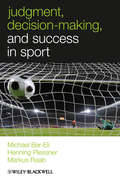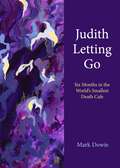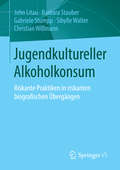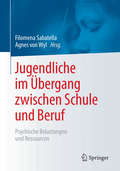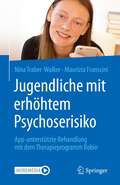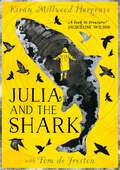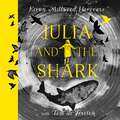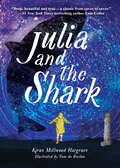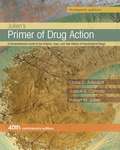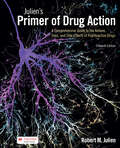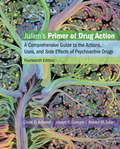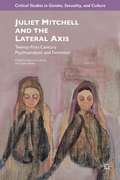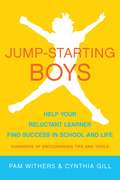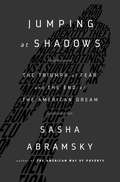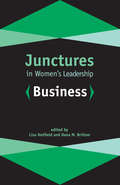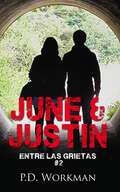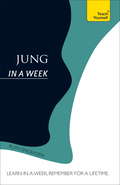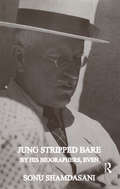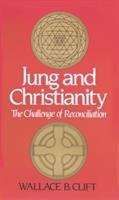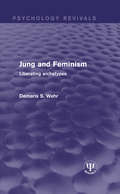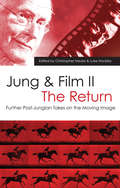- Table View
- List View
Judgment, Decision-making and Success in Sport
by Henning Plessner Michael Bar-Eli Markus RaabJudgment, Decision-Making and Success in Sport presents a thorough overview and assessment of the study of Judgment and Decision-Making (JDM) in sports psychology, and represents an important source of information for those interested in the possible causes and reasons for success and failure in sport.The only book to apply the principles of JDM to sportApplies theory to practice by looking at problems of athletes, coaches, and referees and providing recommendations for dealing with themOffers an overview of current JDM researchUseful for psychologists, physical education teachers, sports scientists, and researchers in this field
Judith Letting Go: Six Months in the World's Smallest Death Cafe
by Mark DowieAn old man learns how to die from a poet facing deathFor the entire six months that Mark Dowie became friends with Judith Tannenbaum, they both knew she was going to die. In fact, for most of that time they knew the exact hour she would go: sometime between 11:00 AM and noon, December 5, 2019, which she did.Judith was a poet, writer, activist, and artist who worked for decades teaching and collaborating with imprisoned lifers. Beloved by her community, Judith told almost no one when she was diagnosed with an incurable disease that would cause her immeasurable pain. Instead she chose to end life on her own terms. When they met, Mark Dowie had already been working for years to advocate for physician assistance in dying for terminally ill people in his home state of California. He helped many friends along this path, but it wasn't until he was introduced to Judith through a mutual friend that he came to a profound new understanding of death. Mark and Judith created a two-person "death café," a group devoted to discussions of death. They talked about many things during Judith's final months, but the rapidly approaching moment of her death came to inform and shape their entire conversation. Death was, as she said, “the undercurrent and the overstory of our relationship.” Judith Letting Go supports the right to plan one’s death, but it is ultimately about the lost human art of releasing everything that matters to the living in preparation for the inevitable.
Jugendkultureller Alkoholkonsum
by Barbara Stauber John Litau Gabriele Stumpp Sibylle Walter Christian WißmannDer Alkoholkonsum Jugendlicher ist seit Jahren allgegenwärtiges Thema in Medien und Fachöffentlichkeit. Zuschreibungen und Dramatisierung bestimmen bisher überwiegend den Diskurs. Kaum werden jedoch die subjektiven und kollektiven Sinnstrukturen dieser riskanten jugendkulturellen Praxis und ihrer biografischen Bedeutung genauer untersucht. Diese Publikation stellt Ergebnisse einer qualitativen Längschnittstudie vor, mit umfassendem Hintergrundwissen zum Phänomen des Umgangs mit Alkohol im Jugendalter. Sie soll bewusst zu einer reflexiven Entdramatisierung der Debatte beitragen.
Jugendliche Lebenswelten
by Peter Martin Thomas Marc CalmbachEin ermutigendes Buch, das endlich einmal nicht den Defizitblick in der Vordergrund stellt, sondern zeigt, wie viele Ressourcen die junge Generation in Deutschland in Wirklichkeit hat. Klaus HurrelmannWie sehen die aktuellen Lebenswelten 14- bis 17-Jähriger in Deutschland aus? Wie denken, fühlen und lernen sie, wie gestalten sie ihren Alltag, wo finden sie Sinn, Chancen und Anerkennung? Eine große Vielfalt an grundlegenden Wertorientierungen, an Alltagseinstellungen etwa zu Schule, Familie, Freizeit, Konsum und Medien sowie Unterschiede in der sozialen Lage kennzeichnen Jugendliche heute. Ähnliche Lebensweisen und Lebensauffassungen gruppiert die Sinus-Jugendforschung in verschiedenen Lebenswelten, die die Vielfalt der Jugend abbilden. Diese Studien des SINUS-Instituts zählen mittlerweile zu den Standardwerken der Jugendforschung und bilden eine wichtige Grundlage für die Arbeit mit jungen Menschen. Jugendliche Lebenswelten befasst sich mit den Fragen, Handlungsanforderungen und Perspektiven, die sich aus der Kenntnis jugendlicher Lebenswelten ergeben. Angesprochen werden Themen wie das Interesse Jugendlicher an Selbstinszenierung und Jugendszenen oder deren Begeisterung für Mode- und Elektronik-Marken. Diese werden oft problemorientiert diskutiert, während die Autorinnen und Autoren in diesem Buch sie als zentrale Facette von Identität auffassen. Bei der Frage nach dem Verständnis von politischer Bildung diskutieren sie , wie man verhindert, "benachteiligte Jugendliche" auszugrenzen. Den zeitlosen Begriffen wie Sinn, Glück und Erfolg und deren unterschiedlichen Bedeutungshorizonten in den verschiedenen Lebenswelten widmet sich ein weiteres Kapitel. Mit den wünschenswerten und notwendigen Implikationen für Politik, Pädagogik und Gesellschaft schließen die Herausgeber von Jugendliche Lebenswelten. Klaus Hurrelmann Wie sehen die aktuellen Lebenswelten 14- bis 17-Jähriger in Deutschland aus? Wie denken, fühlen und lernen sie, wie gestalten sie ihren Alltag, wo finden sie Sinn, Chancen und Anerkennung? Eine große Vielfalt an grundlegenden Wertorientierungen, an Alltagseinstellungen etwa zu Schule, Familie, Freizeit, Konsum und Medien sowie Unterschiede in der sozialen Lage kennzeichnen Jugendliche heute. Ähnliche Lebensweisen und Lebensauffassungen gruppiert die Sinus-Jugendforschung in verschiedenen Lebenswelten, die die Vielfalt der Jugend abbilden. Diese Studien des SINUS-Instituts zählen mittlerweile zu den Standardwerken der Jugendforschung und bilden eine wichtige Grundlage für die Arbeit mit jungen Menschen. Jugendliche Lebenswelten befasst sich mit den Fragen, Handlungsanforderungen und Perspektiven, die sich aus der Kenntnis jugendlicher Lebenswelten ergeben. Angesprochen werden Themen wie das Interesse Jugendlicher an Selbstinszenierung und Jugendszenen oder deren Begeisterung für Mode- und Elektronik-Marken. Diese werden oft problemorientiert diskutiert, während die Autorinnen und Autoren in diesem Buch sie als zentrale Facette von Identität auffassen. Bei der Frage nach dem Verständnis von politischer Bildung diskutieren sie , wie man verhindert, "benachteiligte Jugendliche" auszugrenzen. Den zeitlosen Begriffen wie Sinn, Glück und Erfolg und deren unterschiedlichen Bedeutungshorizonten in den verschiedenen Lebenswelten widmet sich ein weiteres Kapitel. Mit den wünschenswerten und notwendigen Implikationen für Politik, Pädagogik und Gesellschaft schließen die Herausgeber von Jugendliche Lebenswelten.
Jugendliche im Übergang zwischen Schule und Beruf: Psychische Belastungen und Ressourcen
by Filomena Sabatella Agnes Von WylIm Zentrum dieses Buchs steht die psychische Gesundheit junger Menschen im Übergang von der Schule zum Beruf. Diese Übergangsphase ist für viele Jugendliche eine eher schwierige Phase. Das Buch zeigt die Hintergründe der Schwierigkeiten auf und verdeutlicht, warum gering qualifizierte Jugendliche oder diejenigen mit psychischen Belastungen besondere Mühe haben, Anschluss zu finden. Tatsächlich steigt in Übergangsphasen, so auch in der Adoleszenz, das Risiko, eine psychische Erkrankung zu entwickeln. Zudem bringt der im Jugendalter erfolgende Wechsel zwischen Ausbildung und Arbeitswelt einen Anstieg von beruflichen und persönlichen Anforderungen mit sich, den nicht alle bewältigen können. Für Jugendliche und junge Erwachsene ist es jedoch essenziell, im Arbeitsprozess Fuß fassen zu können und integriert zu bleiben, um sich gesund entwickeln zu können. Dieses Buch präsentiert unterschiedliche empirische Arbeiten, die sich mit vielfältigen Aspekten der Übergangsphase zwischen Schule und Arbeit befassen. Die empirischen Befunde werden von relevanten Akteuren aus der Praxis kommentiert. Das Thema dieses Buchs ist von besonderer Bedeutung für die verschiedenen Berufsgruppen aber auch Familienangehörigen, welche Jugendliche in diesem Übergang begleiten, z.B. Eltern, Lehrer oder Coachs. Herausgeberinnen Filomena Sabatella, lic. phil. studierte Psychologie an der Universität Zürich. Zurzeit arbeitet sie am Psychologischen Institut der ZHAW. Ihre Forschungsschwerpunkte liegen vor allem in der Förderung der gesunden psychischen Entwicklung bei Kindern und Jugendlichen und im Bereich der Arbeitsintegration.Prof. Dr. Agnes von Wyl. Leiterin der Fachgruppe Klinische Psychologie und Gesundheitspsychologie des Psychologischen Institut der ZHAW. Langjährige Erfahrung im Bereich der Psychotherapieforschung, Entwicklungspsychopathologie und psychische Gesundheit. Sie ist auch tätig als psychoanalytische Psychotherapeutin.
Jugendliche mit erhöhtem Psychoserisiko: App-unterstützte Behandlung mit dem Therapieprogramm Robin
by Nina Traber-Walker Maurizia FransciniJugendliche, die an einer psychotischen Störung erkranken, können in ihrer Entwicklung stark beeinträchtigt werden und haben insgesamt einen schlechteren Krankheitsverlauf als erwachsene Ersterkrankte. Für eine bessere Prognose ist es wichtig, Patienten mit einem erhöhten Psychose-Risiko frühzeitig zu erkennen und zu behandeln.Während es einige Therapiekonzepte für Frühinterventionen mit Erwachsenen gibt, fehlte es bisher an therapeutischen Konzepten für Jugendliche mit At Risk-Symptomen. Robin ist ein innovatives Therapieprogramm und speziell für Jugendliche entwickelt, mit dem Ziel, den jungen Patienten eine Behandlung anzubieten, die altersgerecht, symptom- und ressourcenorientiert ist. Das Therapiemanual ist aufgrund der Heterogenität dieser Patientengruppe modular aufgebaut. Die Module können den Bedürfnissen der Patienten entsprechend individuell zusammengestellt und angewendet werden. Unterstützt wird die therapeutische Behandlung durch die frei verfügbare Smartphone-App «Robin Z».Dieses Buch richtet sich an Psychiater und Psychotherapeuten, die mit Jugendlichen mit erhöhtem Risiko für die Entwicklung einer Psychose arbeiten und das Therapieprogramm Robin oder Teile davon einsetzen und sich so das moderne Smartphone-Nutzungsverhalten ihrer Patienten zu Nutze machen möchten. Die enthaltenen Therapieunterlagen stehen zusätzlich zum Download bereit, und per „Springer Nature MoreMedia“ App erhalten die Nutzer Videotutorials für die Anwendung in der Therapie.
Juice: A History of Female Ejaculation
by Stephanie HaerdleThe fascinating, little-known history of female sex fluids through the millennia.For over 2000 years, vulval sex fluids were understood to be a natural part of female pleasure, only to become disputed or categorically erased in the twentieth century. Today what do we really know about female ejaculation and squirting? What does the research show, and why are so many details unknown? In Juice, Stephanie Haerdle investigates the cultural history of female genital effluence across the globe and searches for answers as to why female ejaculation—which, according to some reports, is experienced by up to 69 percent of all women and those who have vulvas upon climaxing—has been banished to the margins as just another male sex fantasy.Haerdle charts female juices from the earliest explanations in the erotic writings of China and India, to interpretations of the fluids by physicians, philosophers, and poets in the Middle Ages and early modern period, to their denial, contestation, and suppression in late nineteenth-century Europe. As she shows, the history of ejaculation and squirting is a history of women, their desires, and the worship and denigration of the female body, as well as the cultural concepts of pleasure, sexuality, procreation, the body, masculinity, and femininity. By examining the fantasies and fears that have long accompanied them, Juice restores female gushes to their rightful place in our collective understanding so that they can once again be recognized, named, and experienced.
Julia and the Shark
by Kiran Millwood HargraveA captivating, powerful and luminous story from a bestselling, award-winning author about a mother, a daughter, and the great Greenland shark. With mesmerising black and yellow illustrations and presented as a deluxe hardback with tracing paper inserts, this is a perfect gift for 9+ fans of David Almond and Frances Hardinge.'Tom de Freston's stunning illustrations perfectly complement the poetry of Kiran Millwood Hargrave's story' Cressida Cowell'A truly beautiful book, with text and illustrations in perfect harmony. A book to treasure!' Jacqueline Wilson'Julia and the Shark is deep, beautiful and true. The art shines and the writing soars - a classic from cover to cover' Eoin Colfer'A rich, immersive and wondrous journey, through deep darkness to hope and light' Sophie Anderson, author of The House with Chicken LegsThe shark was beneath my bed, growing large as the room, large as the lighthouse, rising from unfathomable depths until it ripped the whole island from its roots. The bed was a boat, the shark a tide, and it pulled me so far out to sea I was only a speck, a spot, a mote, a dying star in an unending sky...Julia has followed her mum and dad to live on a remote island for the summer - her dad, for work; her mother, on a determined mission to find the elusive Greenland shark. But when her mother's obsession threatens to submerge them all, Julia finds herself on an adventure with dark depths and a lighthouse full of hope...A beautiful, lyrical, uplifting story about a mother, a daughter, and love - with timely themes of the importance of science and the environment.
Julia and the Shark
by Kiran Millwood HargraveA captivating, powerful and luminous story from a bestselling, award-winning author about a mother, a daughter, and the great Greenland shark. Narrated beautifully with atmospheric sound effects, this is a perfect audiobook for 9+ fans of David Almond and Frances Hardinge.'A truly beautiful book, with text and illustrations in perfect harmony. A book to treasure!' Jacqueline Wilson'Julia and the Shark is deep, beautiful and true. The art shines and the writing soars - a classic from cover to cover' Eoin Colfer'A rich, immersive and wondrous journey, through deep darkness to hope and light' Sophie Anderson, author of The House with Chicken LegsThe shark was beneath my bed, growing large as the room, large as the lighthouse, rising from unfathomable depths until it ripped the whole island from its roots. The bed was a boat, the shark a tide, and it pulled me so far out to sea I was only a speck, a spot, a mote, a dying star in an unending sky...Julia has followed her mum and dad to live on a remote island for the summer - her dad, for work; her mother, on a determined mission to find the elusive Greenland shark. But when her mother's obsession threatens to submerge them all, Julia finds herself on an adventure with dark depths and a lighthouse full of hope...A beautiful, lyrical, uplifting story about a mother, a daughter, and love - with timely themes of the importance of science and the environment.(P) 2021 Hodder & Stoughton Limited
Julia and the Shark
by Kiran Millwood Hargrave"Deep beautiful, and true--a classic from cover to cover." --#1 New York Times bestselling author Eoin ColferThere are more secrets in the ocean than in the sky... Ten-year-old Julia loves the mysteries of the ocean and marine biology, just like her scientist mother. Her family is spending the summer on a remote island where her mom is searching for the elusive Greenland shark, a creature that might be older than the trees, and so rare that it&’s only been seen a few times. But the ocean is reluctant to give up its secrets, and Julia tries not to worry as her mother returns disappointed at the end of each day. Determined to prove that the shark is real, Julia sets off on a quest to find it herself, armed with a set of coordinates, a compass, and her trusty rain jacket. She soon realizes that there are some journeys you shouldn&’t go on alone. As Julia comes face to face with the dark and wondrous truths of the sea, she finds the strength to leave the shark in the depths and kick up towards the light. Through a unique blend of poetic prose and stunning illustrations, Julia and the Shark tells an unforgettable story full of dark depths and starry skies, courage and hope. This lyrical, deeply moving middle grade novel about one family&’s fierce love and resilience is perfect for starting conversations about mental health and how it&’s okay to not be okay.
Julien's Primer of Drug Action
by Robert M. Julien Claire D. Advokat Joseph E. ComatyIn its 40th anniversary edition, A Primer of Drug Action continues to evolve side by side with the field it covers, drawing on the expertise of its authors in medicine, basic science, and clinical science to offer the most current and comprehensive guide to psychopharmacology available.
Julien's Primer of Drug Action
by Claire D. Advokat Robert Julien, Ph.D. Joseph ComatyJulien’s enduring classic returns providing a thorough overview of both therapeutic and recreational drugs, including efficacy, mechanisms, and side effects.
Julien's Primer of Drug Action: A Comprehensive Guide to the Actions, Uses, and Side Effects of Psychoactive Drugs (Fourteenth Edition)
by Claire D. Advokat Robert Julien, Ph.D. Joseph ComatyJulien’s Primer of Drug Action continues to evolve side by side with the field it covers providing a thoroughly up to date look at psychotherapeutic and recreational drugs, including the latest research and the newest formulations. The thoroughly updated 14th edition features: New coverage of opioids of abuse, and drugs used to treat of opioid dependence and opioid overdose.New research on the use of marijuana to treat Alzheimers, PTSD, and Epilepsy. New coverage of pharmacological, physiological, and psychoactive effects of synthetic marijuana including its toxicity.New research on Cannabidiol (CBD) and its therapeutic usesNew research of the efficacy of antipsychotics to treat dementia, Parkinson’s, bipolar, OCD, PTSD,New research on hallucinogenics for the treatment of various disorders including MDMA for the treatment of PTSD, Psilocybin for treatment of depression and end-of-life anxiety, and Ayahuasca to treat psychiatric disordersThe use of genetic testing to predict effectiveness of antidepressant treatmentNew research on the use of ketamine for the treatment of depression
Juliet Mitchell and the Lateral Axis: Twenty-first Century Psychoanalysis And Feminism (Critical Studies In Gender, Sexuality, And Culture Ser.)
by Robbie Duschinsky Susan WalkerThis volume fills the gap in books dedicated to the ideas of ground-breaking theorist Juliet Mitchell. Essays from internationally renowned scholars address themes that cross-cut her oeuvre: equality, violence, collective movements, subjectivity, sexuality and power. Mitchell herself contributes a chapter and an afterward.
Jump-Starting Boys
by Pam Withers Dr John Duffy Cynthia GillEveryone knows that boys are falling behind in education. Largely left out of the discussion are parents of boys, who are most aware that their bright, eager sons hit an invisible wall somewhere near fourth grade, after which they become disengaged, discouraged, and disaffected. There are dozens of books on underachieving boys, but most parents brave enough to lift one off the shelf are instantly intimidated by the footnotes, graphs, case studies, and academic-speak addressed almost entirely to educators. What about the average guilt-ridden, frustrated mother or father of an underachieving boy? Jump-Starting Boys is the first book on the market that empowers parents, helping them reclaim the duties and rewards of raising their children and navigate the influences of school and media. Filled with reassurance and support, the authors turn fear and guilt into can-do confidence. Through easy tips and action list sidebars, this is the most practical, readable book on the topic.
Jump-Starting Boys: Help Your Reluctant Learner Find Success in School and Life
by Pam WithersEveryone knows that boys are falling behind in education. Largely left out of the discussion are parents of boys, who are most aware that their bright, eager sons hit an invisible wall somewhere near fourth grade, after which they become disengaged, discouraged, and disaffected. There are dozens of books on underachieving boys, but most parents brave enough to lift one off the shelf are instantly intimidated by the footnotes, graphs, case studies, and academic-speak addressed almost entirely to educators. What about the average guilt-ridden, frustrated mother or father of an underachieving boy? Jump-Starting Boys is the first book on the market that empowers parents, helping them reclaim the duties and rewards of raising their children and navigate the influences of school and media. Filled with reassurance and support, the authors turn fear and guilt into can-do confidence. Through easy tips and action list sidebars, this is the most practical, readable book on the topic.
Jumping at Shadows: The Triumph of Fear and the End of the American Dream
by Sasha AbramskyWhy is an unarmed young black woman who knocks on a stranger's front door to ask for help after her car breaks down perceived to be so threatening that he shoots her dead? Why do we fear infrequent acts of terrorism more far more common acts of violence? Why does a disease like Ebola, which killed only a handful of Americans, provoke panic, whereas the flu--which kills tens of thousands each year--is dismissed with a yawn?Jumping at Shadows is Sasha Abramsky's searing account of America's most dangerous epidemic: irrational fear. Taking readers on a dramatic journey through a divided nation, where everything from immigration to disease, gun control to health care has become fodder for fearmongers and conspiracists, he delivers an eye-popping analysis of our misconceptions about risk and threats. What emerges is a shocking portrait of a political and cultural landscape that is, increasingly, defined by our worst fears and rampant anxieties.Ultimately, Abramsky shows that how we calculate risk and deal with fear can teach us a great deal about ourselves, exposing deeply ingrained strains of racism, classism, and xenophobia within our culture, as well as our growing susceptibility to the toxic messages of demagogues.
Junctures in Women's Leadership: Business
by Dana M. Britton Laura Lovin Carolina Alonso Bejarano Rosemary Ndubuizu Stina Soderling Amanda Roberti Professor Lisa Hetfield Katie Mccollough Crystal Bedley Grace HowardHow have women managed to break through the glass ceiling of the business world, and what management techniques do they employ once they ascend to the upper echelons of power? What difficult situations have these female business leaders faced, and what strategies have they used to resolve those challenges? Junctures in Women's Leadership: Business answers these questions by highlighting the professional accomplishments of twelve remarkable women and examining how they responded to critical leadership challenges. Some of the figures profiled in the book are household names, including lifestyle maven Martha Stewart, influential chef Alice Waters, and trailblazing African-American entrepreneur Madame C.J. Walker. Others have spent less time in the public eye, such as Johnson & Johnson executive JoAnn Heffernan Heisen, Verizon Senior Vice President Diane McCarthy, Wells Fargo technology leader Avid Modjtabai, Xerox CEO Ursula Burns, Spanx founder Sara Blakely, inventor Jane ni Dhulchaointigh, engineering firm President Roseline Marston, Calvert Investments President and CEO Barbara Krumsiek, and Merrill Lynch executive Subha Barry. These women, from diverse backgrounds, have played important roles in their respective corporations and many have worked to improve the climate for women in male-dominated industries. This is a book about women who are leading change in business. Their stories illuminate the ways women are using their power and positions--whether from the middle ranks or the top, whether from within companies or by creating their own companies. Each case study in Junctures in Women's Leadership: Business includes a compelling and instructive story of how a woman business leader handled a critical juncture or crisis in her career. Not only does the book offer an inspiring composite portrait of women succeeding in the business world, it also provides leadership lessons that will benefit readers regardless of gender.
June & Justin, Entre las Grietas #2
by P. D. WorkmanJustin había cometido un error. Un gran error que cambia la vida. Ya le falló a junio una vez. Él no estuvo allí cuando ella lo necesitó y, gracias a él, sus vidas nunca volverán a ser las mismas. June lo es todo para Justin, y él debe serlo todo para ella. Debe proteger a June a toda costa. Justin está preparado para pasar el resto de su vida evitando que ella vuelva a lastimarse. Pero parece que siempre se están quedando atrás, apenas un paso por delante de las pesadillas. Siempre hay un peligro más, a la vuelta de la esquina.
Jung In A Week: Teach Yourself
by Ruth SnowdenLearn in a week, remember for a lifetime!In just one week, this accessible book will give you knowledge to last forever. End of chapter summaries and multiple choice questions are all designed to help you test your knowledge and gain confidence. So whether you are a student or you simply want to widen your knowledge, you will find this seven-day course a very memorable introduction.Sunday: Learn who Jung was and what he didMonday: Explore Jung's inner world and how this informed his ideasTuesday: Understand Jung's view of the psyche and its journeyWednesday: Consider Jung's views on dreams and symbolsThursday: Engage with Jung's understanding of personality and how we form relationshipsFriday: Find out what Jung thought about esoterica, the paranormal, religion and spirituality.Saturday: Look at how Jung's ideas have been developed over time and how they are relevant today.
Jung In A Week: Teach Yourself
by Ruth SnowdenLearn in a week, remember for a lifetime!In just one week, this accessible book will give you knowledge to last forever. End of chapter summaries and multiple choice questions are all designed to help you test your knowledge and gain confidence. So whether you are a student or you simply want to widen your knowledge, you will find this seven-day course a very memorable introduction.Sunday: Learn who Jung was and what he didMonday: Explore Jung's inner world and how this informed his ideasTuesday: Understand Jung's view of the psyche and its journeyWednesday: Consider Jung's views on dreams and symbolsThursday: Engage with Jung's understanding of personality and how we form relationshipsFriday: Find out what Jung thought about esoterica, the paranormal, religion and spirituality.Saturday: Look at how Jung's ideas have been developed over time and how they are relevant today.
Jung Stripped Bare: By His Biographers, Even
by Sonu ShamdasaniHow many "posthumous" lives does a man have to live? Nearly half a century after his death, C. G. Jung is a subject of continual controversies. Every few years, a new life of Jung appears, each promising to provide the missing master key to the mysteries of his life and work, and to lay bare their secrets. However, with every successive "life", Jung becomes shrouded in an ever-increasing web of rumour, gossip, innuendo and fantasy. We may ask why Jung biographies are so filled with shortcomings? How did Jung become a fiction? This book addresses these issues. It demonstrates the pitfalls and fallacies of such works, and sets out how his life and work should be approached on a historical basis, drawing on decades of archival investigation and new documentation. It surveys attempts to write Jung's biography from during his own lifetime until the present; shows how Memories, Dreams, Reflections came to be falsely perceived as his autobiography; and why his Collected Works was never completed. Thus this work lays out an agenda for future studies and discussions of Jung, the reception of his work and its impact on contemporary culture.
Jung and Christianity: The Challenge of Reconciliation
by Wallace B. CliftA parish minister attempts to answer the challenge presented to Christianity in the last decade of Jung's life--to make the teachings real in this day and age, and offer true enlightenment of the soul.
Jung and Feminism: Liberating Archetypes (Psychology Revivals)
by Demaris S. WehrJung, in contrast to Freud, has typically been considered more sympathetic to women largely because of his emphasis on the feminine as a way of being in the world and on the ‘anima’, the unconscious feminine aspect of male personality. Feminists, however, have viewed Jung’s whole notion of the ‘feminine’ with suspicion, seeing it as a projection of male psyche and not an authentic understanding of female humanity. For Demaris Wehr both feminism and Jungian psychology have been guiding forces, and in this book, originally published in 1988, she mediates between feminists and classical Jungians – two groups historically at odds. She faces squarely the male-centred assumptions of some Jungian concepts and challenges Jung’s claims for the universality and purely empirical basis of his work, but nevertheless maintains an appreciation for the value of Jung’s understanding of human nature and the process of individuation. By bringing the insights of feminist theology to bear on the seemingly unbridgeable gap between analytical psychology and feminism, she succeeds in reclaiming Jungian psychology as a freeing therapy for women and reveals it as the ultimately liberating vision its founder intended it to be.
Jung and Film II: Further Post-Jungian Takes on the Moving Image
by Luke Hockley Christopher HaukeSince Jung and Film was first published in 2001, Jungian writing on the moving image in film and television has accelerated. Jung and Film II: The Return provides new contributions from authors across the globe willing to tackle the broader issues of film production and consumption, the audience and the place of film culture in our lives. As well as chapters dealing with particular film makers such as Maya Derren and films such as Birth, The Piano, The Wrestler and Breaking the Wave, there is also a unique chapter co-written by documentary film-maker Tom Hurvitz and New York Jungian analyst Margaret Klenck. Other areas of discussion include: the way in which psychological issues come under scrutiny in many movies the various themes that concern Jungian writers on film how Jungian ideas on psychological personality types can be applied in fresh ways to analyse a variety of characters. The book also includes a glossary to help readers with Jungian words and concepts. Jung and Film II is not only a welcome companion to the first volume, it is an important stand- alone work essential for all academics and students of analytical psychology as well as film, media and cultural studies.
